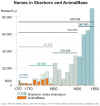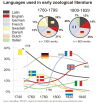Sherborn's Index Animalium: New names, systematic errors and availability of names in the light of modern nomenclature
- PMID: 26877658
- PMCID: PMC4741220
- DOI: 10.3897/zookeys.550.10041
Sherborn's Index Animalium: New names, systematic errors and availability of names in the light of modern nomenclature
Abstract
This study is aimed to shed light on the reliability of Sherborn's Index Animalium in terms of modern usage. The AnimalBase project spent several years' worth of teamwork dedicated to extracting new names from original sources in the period ranging from 1757 to the mid-1790s. This allowed us to closely analyse Sherborn's work and verify the completeness and correctness of his record. We found the reliability of Sherborn's resource generally very high, but in some special situations the reliability was reduced due to systematic errors or incompleteness in source material. Index Animalium is commonly used by taxonomists today who rely strongly on Sherborn's record; our study is directed most pointedly at those users. We recommend paying special attention to the situations where we found that Sherborn's data should be read with caution. In addition to some categories of systematic errors and mistakes that were Sherborn's own responsibility, readers should also take into account that nomenclatural rules have been changed or refined in the past 100 years, and that Sherborn's resource could eventually present outdated information. One of our main conclusions is that error rates in nomenclatoral compilations tend to be lower if one single and highly experienced person such as Sherborn carries out the work, than if a team is trying to do the task. Based on our experience with extracting names from original sources we came to the conclusion that error rates in such a manual work on names in a list are difficult to reduce below 2-4%. We suggest this is a natural limit and a point of diminishing returns for projects of this nature.
Keywords: Sherborn.
Figures



Similar articles
-
'Where is the damned collection?' Charles Davies Sherborn's listing of named natural science collections and its successors.Zookeys. 2016 Jan 7;(550):83-106. doi: 10.3897/zookeys.550.10073. eCollection 2016. Zookeys. 2016. PMID: 26877654 Free PMC article.
-
Unlocking Index Animalium: From paper slips to bytes and bits.Zookeys. 2016 Jan 7;(550):153-71. doi: 10.3897/zookeys.550.9673. eCollection 2016. Zookeys. 2016. PMID: 26877657 Free PMC article.
-
Naming and Necessity: Sherborn's Context in the 19(th) Century.Zookeys. 2016 Jan 7;(550):57-69. doi: 10.3897/zookeys.550.7399. eCollection 2016. Zookeys. 2016. PMID: 26877652 Free PMC article.
-
Formation of prokaryote names from personal names: a review of current practice and a proposal to emend Appendix 9 of the International Code of Nomenclature of Prokaryotes.Int J Syst Evol Microbiol. 2024 Jan;74(1). doi: 10.1099/ijsem.0.006233. Int J Syst Evol Microbiol. 2024. PMID: 38226641 Review.
-
Synthetic cannabinoid receptor agonists: classification and nomenclature.Clin Toxicol (Phila). 2020 Feb;58(2):82-98. doi: 10.1080/15563650.2019.1661425. Epub 2019 Sep 16. Clin Toxicol (Phila). 2020. PMID: 31524007 Review.
Cited by
-
Charles Davies Sherborn and the "Indexer's Club".Zookeys. 2016 Jan 7;(550):13-32. doi: 10.3897/zookeys.550.9697. eCollection 2016. Zookeys. 2016. PMID: 26877650 Free PMC article.
-
A common registration-to-publication automated pipeline for nomenclatural acts for higher plants (International Plant Names Index, IPNI), fungi (Index Fungorum, MycoBank) and animals (ZooBank).Zookeys. 2016 Jan 7;(550):233-46. doi: 10.3897/zookeys.550.9551. eCollection 2016. Zookeys. 2016. PMID: 26877662 Free PMC article.
-
A magpie with a card-index mind - Charles Davies Sherborn 1861-1942.Zookeys. 2016 Jan 7;(550):33-56. doi: 10.3897/zookeys.550.9975. eCollection 2016. Zookeys. 2016. PMID: 26877651 Free PMC article.
-
The use and limits of scientific names in biological informatics.Zookeys. 2016 Jan 7;(550):207-23. doi: 10.3897/zookeys.550.9546. eCollection 2016. Zookeys. 2016. PMID: 26877660 Free PMC article.
-
'Where is the damned collection?' Charles Davies Sherborn's listing of named natural science collections and its successors.Zookeys. 2016 Jan 7;(550):83-106. doi: 10.3897/zookeys.550.10073. eCollection 2016. Zookeys. 2016. PMID: 26877654 Free PMC article.
References
-
- Blanchard R, von Maehrenthal F, Stiles CW. (1905) Règles internationales de la nomenclature zoologique adoptées par les Congrès International de Zoologie; International Rules of Zoological Nomenclature; Internationale Regeln der Zoologischen Nomenklatur. FR de Rudeval, Paris, 57 pp.
-
- Denis JNCM, Schiffermüller I. (1775) Ankündung eines systematischen Werkes von den Schmetterlingen der Wienergegend, herausgegeben von einigen Lehrern am k. k. Theresianum. Wien, 322 pp http://resolver.sub.uni-goettingen.de/purl?PPN574458115
-
- Evenhuis NL. (2016) Charles Davies Sherborn and the “Indexer’s Club”. In: Michel E. (Ed.) Anchoring Biodiversity Information: From Sherborn to the 21st century and beyond. ZooKeys 550: 13–32. doi: 10.3897/zookeys.550.9697 - DOI - PMC - PubMed
-
- Forskål P. (1775) Descriptiones animalium avium, amphibiorum, piscium, insectorum, vermium; quæ in itinere orientali observavit Petrus Forskål. Post mortem auctoris edidit Carsten Niebuhr. Adjuncta est materia medica Kahirina atque tabula maris rubri geographica. Möller, Hauniæ, 164 pp http://www.biodiversitylibrary.org/item/18564
-
- Forster JR. (1781) Indische Zoologie oder systematische Beschreibungen seltener und unbekannter Thiere aus Indien, mit 15 illuminirten Kupfertafeln erläutert. Nebst einer kurzen vorläufigen Abhandlung über den Umfang von Indien und die Beschaffenheit des Klima, des Bodens und des Meeres daselbst, und einem Anhange, darin ein kurzes Verzeichniß der Thiere in Indien mitgetheilt wird. Zoologia Indica selecta tabulis XV aeneis illustrata. Praemittitur de finibus et indole aeris, soli, marisque Indici brevis lucubratio. Seqvitur ad calcem brevis enumeratio animalium Indiae. Gebauer, Halle, 42 pp http://resolver.sub.uni-goettingen.de/purl?PPN600894029
LinkOut - more resources
Full Text Sources
Other Literature Sources
Miscellaneous
